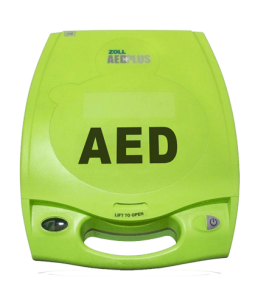If you are interested in acquiring an automated external defibrillator (AED), either for the first time or to add to your program, read on to see if the Zoll AED Plus® device will suit your needs. The Zoll AED Plus, manufactured by ZOLL Medical, is the versatile go-to model for those who want a reliable, intuitive device. This model was introduced by Zoll in 2001 and immediately filled a need in the market for both trained and untrained rescuers. The bright green color of the Zoll AED Plus catches the eye right away, which helps potential rescuers easily remember and locate the AED. The AED Plus also has graphical images which alert the rescuer that they can prop the lid under the victim’s neck to open their airway passage. The large graphic images on the Zoll AED Plus faceplate simplify the instructions and help lay people understand the steps of the rescue process. The device guides the rescuer through each step leaving nothing to question. Not only does the Zoll AED Plus have step-by-step visual and audio prompts to help the rescuer stay calm and focused, it also helps the rescuer avoid the two most common pitfalls of CPR—inadequate chest compression depth (2 inches) and rate (100 reps/minute). As CPR is being administered, the device will display a bar graph for easy visualization and give audio feedback telling the rescuer “Good Compressions” or “Push Harder.” The Zoll AED Plus, Real CPR Help converts compression data instantaneously from the CPR-D padz and provides an adaptive metronome to help the rescuer with the proper chest compression rate. The device also operates with a one-piece electrode allowing for quick pad placement directly in the center of the victim’s chest. The value of these unique features has helped save many lives by eliminating confusion and giving the rescuer confidence during a chaotic event. The Zoll AED Plus is the only AED on the market that runs on long-lasting lithium batteries. Not only are these accessible and affordable, but they are easy to replace and will last five years in standby mode. The expiration date on the CPR-D adult electrodes is also five years, which cuts down on AED maintenance and unnecessary confusion.

